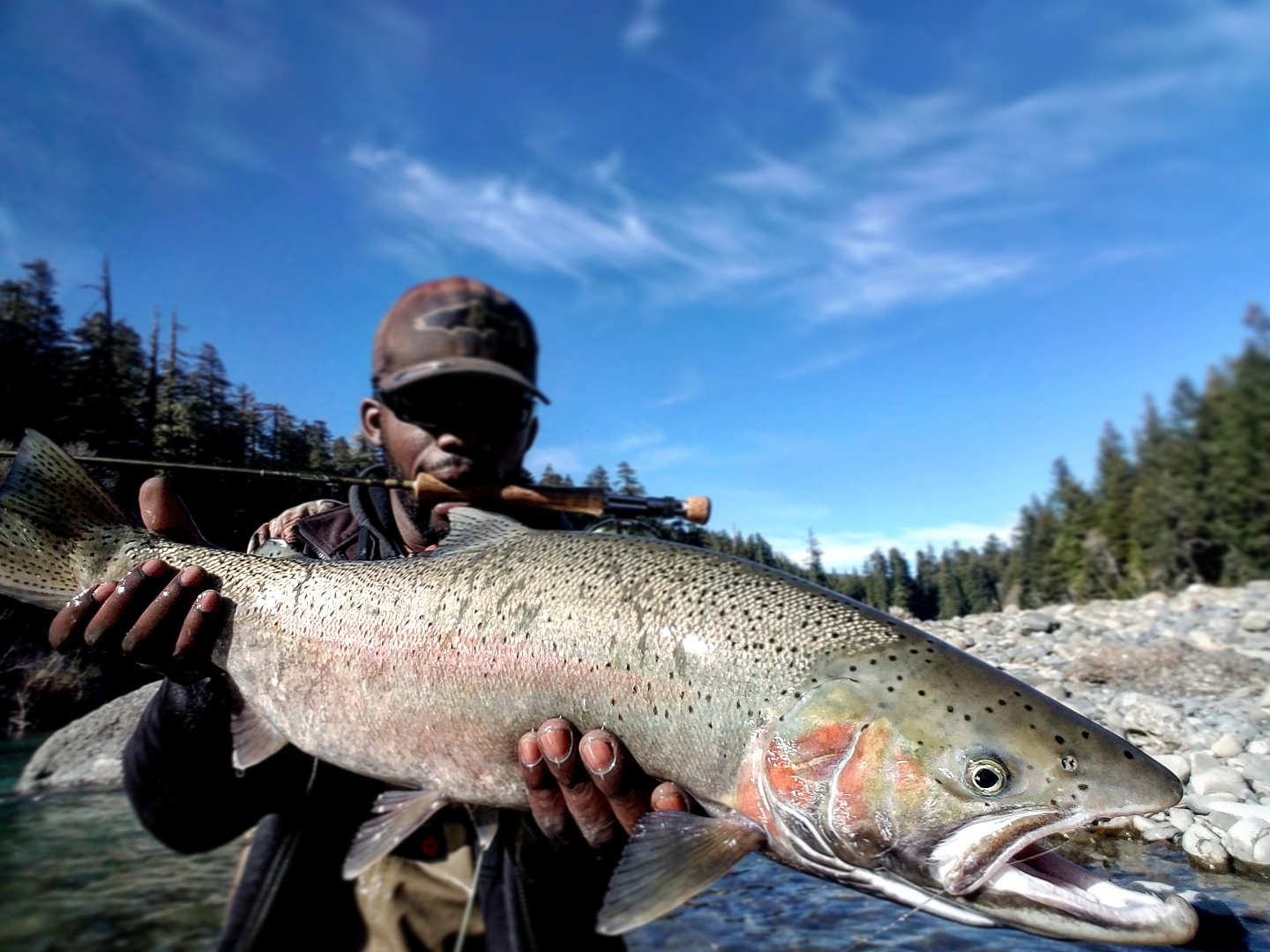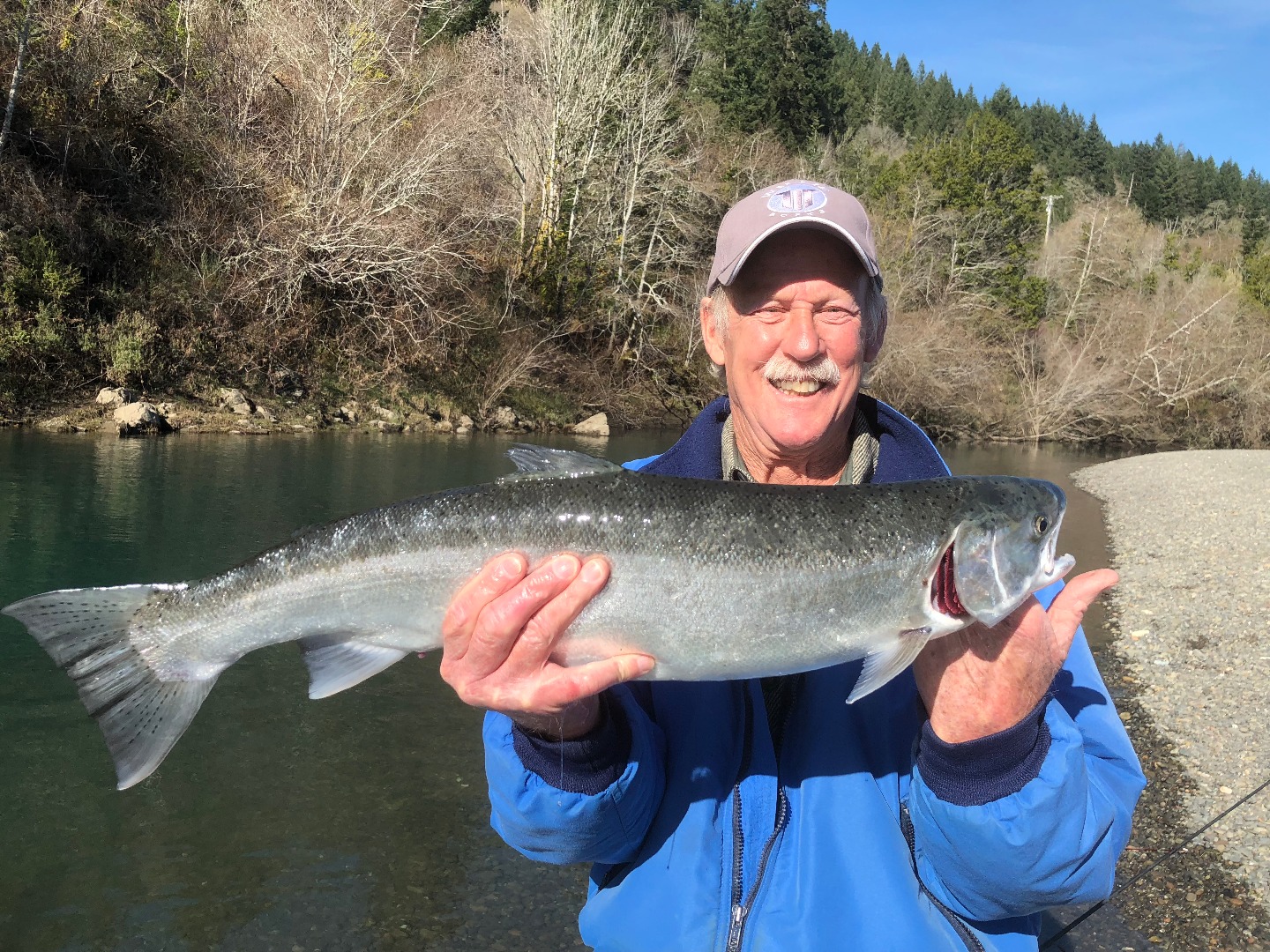Van Duzen River Fish Report for 2-22-2018
Klamath salmon on the rebound
Van Duzen River - Bridgeville, CA

by Kenny Priest
2-22-2018
Website
We’ve got a long way to go, but it looks like the worst may be over for the run of fall kings on the Klamath. In 2016, the number of returning Fall Chinook adults to the Klamath River was estimated at 27,353. At the time, those were the lowest returns ever recorded. In 2017, CDFW predicted the numbers would go even lower. Only 18,410 kings were predicted to return, prompting a full closure of the fall season on the Klamath. North Coast ocean anglers also took a hit. Both the California and Oregon Klamath Management Zones (KMZ) were closed to recreational salmon fishing in 2017 due to the Klamath’s low returns. According to the Pacific Fishery Management Council (PFMC), which released its “Review of 2017 Ocean Salmon Fisheries” document last Thursday, the 2017 preliminary postseason river run size estimate for Klamath River Fall Chinook was 31,838 adults, a 42 percent increase of what was predicted. The escapement to natural spawning areas was 18,514 adults, which was 163 percent of the preseason prediction of 11,379 adults. Based on the 2017 returns, it looks like the stocks are rebuilding a year ahead of schedule.
The estimated hatchery return was 11,213 adults. Jack returns to the Klamath Basin totaled 21,903 including 16,522 that escaped to natural spawning areas. The average number of jack returns over the last 5 seasons is 13,398, so these are huge improvements and a good indicator of the number of three-year old’s that are in the ocean and could potentially return to the river next fall.
Spawning escapement to the upper Klamath River tributaries (Salmon, Scott, and Shasta Rivers), totaled 6,894 adults, up from 5,462 in 2016. The Shasta River has historically been the most important Chinook salmon spawning stream in the upper Klamath River, supporting a spawning escapement of 27,600 adults as recently as 2012 and 63,700 in 1935. The escapement in 2017 to the Shasta River was 3,287 adults. Escapement to the Salmon and Scott Rivers was 1,338 and 2,269 adults, respectively.
According to the report, the Yurok and Hoopa Valley tribes shared a federally-reserved right of 50 percent (814) of the available harvest surplus of adult Klamath fall Chinook. Tribal adult harvest was 1,876 (Yurok: 216 adults; Hoopa Valley: 1,660 adults), which was 230 percent of the tribal allocation. The river recreational fishery for fall Chinook in the Klamath Basin was closed in 2017. However, 71 fall Chinook adults were estimated to have been harvested, almost entirely during the spring Chinook fishery.
We’re not out of the woods by any means, but the numbers are now headed in the right direction. The hope is we’ll have some sort of fall quota for the Klamath Basin, and the recreational ocean salmon anglers will get some time on the water as well.
Next up is the annual Ocean Salmon Information meeting, which will be held March 1 from 10:00 a.m. to 4:00 p.m. at the Sonoma County Water Agency office located at 404 Aviation Blvd. in Santa Rosa. Ocean abundance will be discussed, which will then trickle down to river quotas. For more information on the meeting, please contact CDFW Environmental Scientist Kandice Morgenstern at 707-576-2879, Kandice.Morgenstern@wildlife.ca.gov. or visit www.wildlife.ca.gov/oceansalmon
The weather ahead
“The general weather pattern for the next week will remain the same, storm patterns will be coming out of the north with low elevation snow,” said Ryan Aylward of Eureka’s National Weather Service. “On Thursday, we’ll see a little precipitation. Most will fall in the mountains, where we could see close to a half-inch. We’ll see a couple tenths closer to the coast. Snow levels will be down to 1,000 feet. Friday is looking clear, with a weak system forecasted for Saturday. Snow levels will be between 1,500 and 2,000 feet, with the Smith River predicted to rise about a foot from the rain and snow melt. Another system will roll through on Sunday, and it’s looking a little more wet. The models are calling for three-quarters of an inch in the mountains of Del Norte, and a half-inch at the coast. Only a couple tenths are predicted for the Eureka area. Lingering showers are forecasted for Monday, we should see another couple tenths of an inch. Right now, Tuesday and Wednesday are looking dry.”
Leader Length Restriction begins March 1
A reminder that the new leader length restriction will go into effect on March 1. The regulation states: It shall be unlawful to use any configuration of fishing tackle in anadromous waters unless the distance between the terminal hook or terminal lure and any weight attached to the line or leader, whether fixed or sliding, is less than six feet. For purposes of this section, “weight” includes any product used to submerge the line or leader, including non-buoyant artificial flies or artificial lures, but does not include integrated or sinking fly fishing lines, lead core lines used while trolling from a boat, dropper weights used while trolling from a boat, or clipped weights used with downrigger systems.
The Rivers:
Chetco/Elk/Sixes
“The Chetco fished decently during Monday’s winter weather, with some boats hooking up to four fish,” said Andy Martin of Wild Rivers Fishing. “Things had slowed again by Tuesday. The freezing weather and snow has caused the river to drop even more. This weekend’s storm should provide relief to the low, clear conditions.”
Fishing has been slow on the Elk and Sixes. The Elk has remained around 3 feet according to Martin.
Smith River
The Smith remains low and clear and conditions are tough, reports Mike Coopman of Mike Coopman’s Guide Service. He said, “Boats are getting a couple chances per day. There’s pods of fish in the river, just getting them to bite in the cold and low water is tough. We’re seeing quite a few fish spawning in the upper river, which is good. A few downers have been reported up high as well.”
Eel River (main stem)
The main stem is dropping and getting clear, but it’s the best game in town. Boats drifting from the forks to the lower river are averaging three to four fish per trip. Fish are coming on both yarn and bait as well as plugs. There’s some nice adults in the mix as well as a good number of half-pounders. Flows were right around 1,700 cfs as of Wednesday.
Eel River (South Fork)
According to Darren Brown of Brown’s Sporting Goods in Garberville, the river is low and clear. He said, “Most of the anglers are down on the main stem, there’s a few guys around here. but not many. With the water conditions, you’ll need to cover some ground.” Flows are just over 300 cfs as of Wednesday.
Van Duzen
The Van Duzen is low, hovering just above 200 cfs on Wednesday. Bank anglers are catching a few, but getting a little too low to drift.
Mad River
The Mad is still in good shape, but the fishing has slowed down from last week, reports Justin Kelly of Eureka’s RMI Outdoors. “The water has some color, but it is starting to clear. We’ve got a little rain and snow melt coming through the weekend, so the bump in the flows should help. There’s still plenty of fish in the river, but they’re scattered. We’re starting to see a bunch of three to five-pound wild fish around now, but there are still a few hatchery fish in the mix. Fishing pressure has tapered off quite a bit.” added Kelly.
Kenny Priest operates Fishing the North Coast, a fishing guide service out of Humboldt specializing in salmon and steelhead. Find it on Facebook, Instagram, YouTube and www.fishingthenorthcoast.com. For up-to-date fishing reports and North Coast river information, email kenny@fishingthenorthcoast.com.
More Reports
Despite low flows, steelhead options are plenty
Smith River2-15-2018
While the lack of rain has most steelhead anglers singing the blues, there are however, a few bright spots. Especially...... Read More
Rivers are green, but bite is slow
Chetco River
2-8-2018
This past weekend saw all of our coastal steelhead rivers turn some shade of green – some emerald and some...... Read More

Website Hosting and Design provided by TECK.net